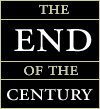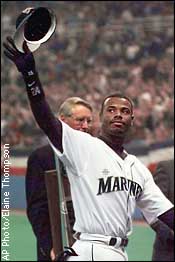 |
|
| | Thursday, March 2 | |||||
ESPN.com | ||||||
| If you stepped into a time machine and turned the clock back to 1900, you would still recognize the game of baseball. The same cannot be said for basketball or football. Oh, there weren't many home runs and starting pitchers completed nearly every start, but it was still the same game. The bases were 90 feet apart and three strikes meant you were out. Heck, even then players and owners constantly squabbled over money.
What about the next 100 years?
Will anybody break Hank Aaron's record of 755 home runs? At this point, it appears inevitable. Mark McGwire has 522 career home runs and in the Stats Major League Handbook 2000, Bill James estimates Big Mac has a 48 percent chance of breaking Aaron's mark. He estimates Ken Griffey Jr. with a 44 percent chance to get to 756 and a 34 percent chance to reach 800. And if those two slow down, there are plenty of young players like Alex Rodriguez and Vladimir Guerrero on the chase. Our prediction? McGwire breaks the mark and retires soon afterwards. Griffey then surpasses Mac and finishes with 812 lifetime dingers.
Baseball's richest team also has one of the best farm systems around. In order to beat the Yankees, teams will have to excel at finding international talent, continue to scout domestic players well and sign the right free agents. It takes money to do this, of course, but it also takes smarts. The Astros have built the best Venezuelan pipeline and open a new ballpark in 2000. The Indians have a solid farm system and a new owner (Charles Dolan) who may spend more money on payroll than Dick Jacobs. The Red Sox have made great roads into Asia, although a new Fenway would help matters. Those three teams are best positioned to make a run at the Yankees in the next decade. International influence Besides the obvious Latin factor, we're already seeing a large influx of Japanese and Korean players reaching the major leagues. Baseball is in a constant search for new talent bases. Venezuela is the new Dominican Republic. The sport is gaining popularity in Australia. Where are the next hotbeds? Here are three countries to watch: 1. China. Yes, baseball is being played in China. Since baseball is popular in other Asian countries, there is a good chance it will grow in popularity in China as well. And since baseball is a sport that doesn't necessarily require enormous size (like football and basketball), the Chinese could excel. Besides, there are more than a billion people in China, so the odds of finding a number with the skills it takes to play baseball are good. Look for them to be making a major impact the second half of the century and perhaps sooner. 2. Brazil. With a sizable population and a healthier economy than most South American countries, baseball could take off here. No, it won't surpass soccer, but there are already several Brazilians in the minor leagues. 3. Netherlands. Baseball isn't big in Europe, but the Netherlands and Italy are two countries that have picked up the sport. The Dutch are gaining respect and starting to play competitively in international tournaments. What will happen to the game's popularity? Baseball attendance was on a big upswing in the early '90s when the strike hit in 1994 and only now is the game reaching the record attendance levels of 1993 (thanks, Sammy and Mark). While television ratings will never reach the levels when there were just three major networks to choose from, it certainly isn't positive news that the past two World Series were the lowest-rated Fall Classics ever. However, despite the Yankees' four-game sweep this year, NBC did manage to turn a small profit. So, what will the 21st century hold for the game's popularity? Let's look at some of the negative issues: 1. The game is too slow. Kids today grow up with short attention spans. They like action and violence and blood (well, at least in their video games). They won't care as much about the game's history and nostalgia that keeps older fans interested. Solution: Keep the home runs coming. Fans love offense, always have and always will. Baseball has talked about increasing the height of the mound to give pitchers a fair chance against today's juiced-up sluggers and bandbox ballparks. But a more "balanced" game could mean loss in fan interest. Let's face it: is there really anything wrong with the threat of a player hitting 70 home runs in any given year? 2. Ticket prices. One of baseball's biggest benefits has always been relatively inexpensive tickets. Joe Worker could afford to take his family to a ballgame, or several ballgames, every season. However, with several teams now selling $50 box seats, baseball ticket prices are turning ballparks into larger replicas of NBA arena -- lots of corporate suits in the front row. Solution: Face it -- prices won't come tumbling down. Owners will always price tickets as high as they possibly can as long people buy them. It's called supply-and-demand. Plus, if Joe Worker is watching the game at home on television that is fine for owners as well, since we all know TV is where the big money comes from. 3. Disparity. Perhaps the most important trend of the '90s was the increasing disparity between teams. The 1980s was the most competitive decade in history and that helped the game's popularity. However, we're starting to see more 100-win teams than ever before -- and many more 90-loss teams. This reflects at the box office, where fans of teams like Montreal and Kansas City essentially give up before the season even begins. This just makes the income levels between the haves and have-nots more dramatic. Solution: The simple fact is some teams have to will have to move. Right now, baseball is not viable in some cities -- at least, if the teams want to win. The Expos have little chance of reaching the playoffs with their payroll, although they're not losing money. In fact, there has been talk of some teams folding. This is extremely unlikely. First of all, the powerful Players Assocation would never agree to this. Second, there are still lots of rich folks who want to buy a major league baseball franchise. But our prediction? In 2004, the Expos move to Charlotte. In 2008, the Twins move to Orlando. In 2011, the A's move to Las Vegas. As for expansion, it makes sense to expand to 32 teams with eight four-team divisions. This will probably happen within 10 years. Northern Virginia will get a team, as will San Jose. Innovations Schedule: The regular season will be shortened from 162 games to 140 games. This serves two main purposes. One, with fewer quality pitchers, teams won't have to use bad pitchers as often. That means when you go to a game, you are more likely to see Pedro Martinez pitch (i.e., a better justification for higher ticket prices). More importantly, it will allow for an expanded playoff system. Our prediction: Look for 12 teams to make the playoffs by 2010, with four teams getting first-round byes. Equipment: Baseball equipment has remained essentially unchanged for 100 years. Ever since Roger Bresnahan started wearing catcher's shin guards in the early 1900s, the three main innovations have been the batting helmet, batting glove and elbow pad (the better to get hit by a pitch, my dear!). The biggest question: Will major leaguers ever use aluminum bats? Our prediction: In 2042, Trey Griffey II breaks the single-season home run record and goes on to shatter his grandfather's career mark. Using a modified carbon/aluminum bat that sounds just like wood. Rules: The game revolves around balls and strikes and 27 outs. Will this ever change? There is no doubt that as the average game time approaches three hours, execs are worried. Our prediction: Four balls and three strikes won't change but games will be shortened to seven innings in 2058. Uniforms: Will those garish "Back to the Future" uniforms come into play? Hey, who knows what the fashion trends in 2037 will be? One thing we know will happen is advertising on uniforms. (Of course, we already have that with the ubiquitous swoosh, don't we?) Prediction: It's worked for European soccer teams, it will work for North American pro sports franchises. It will start small with ads on the sleeves by 2002 and will grow from there. You think Coca-Cola would shell out millions to have their logo across the chests of the Atlanta Braves? You bet. Think 2010. Player movement 1. Charlie Finley's wish will come true: Owners will eventually wise up and abolish free agency by allowing all players to become free agents every year (unless they sign long-term contracts). In essence, this would drive down player salaries because there won't be a limited supply of talent available on the open market. It will allow younger players who haven't reached free agent status to earn more money. 2. The amateur draft: Right now, only American, Canadian and Puerto Rican players are subject to the draft. Soon, all foreigners will. Later, however, the draft will be abolished altogether thanks to Scott Boras' lawsuit. 3. Forced trades: Think about it. Vladimir Guerrero is one of baseball's best players, but the Spanish-speaking outfielder plays in French-speaking Montreal. Imagine how big of a star he would be in Los Angeles or Miami or other cities with large Hispanic populations. With the increasing number of Latin players and the growing Hispanic population in the U.S., baseball needs to market its Latin players. There will come a time when certain players will be allocated to specific teams in order to maximize their marketing potential. Will Pete Rose make the Hall of Fame? Well, 100 years is a long time. David Schoenfield is the baseball editor at ESPN.com. | ALSO SEE Off Base: January Madness!  | |||||

